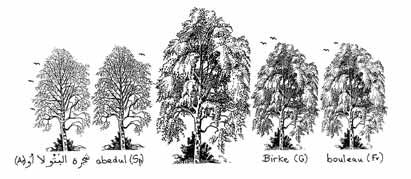|
|
|
| Colney Nature Watch |
| A series of articles on the wild life in London Colney |
| Birches |

I love birch trees. Their slender silver trunks. The masses of pale green leaves. They’re all over this village - in playgrounds, by schools and in the local woods.
A birch tree is a kind of power station, helping undo the effects of global warming. Their roots go deep. They suck up moisture, and in the leaves, the sunlight combines water with atmospheric carbon dioxide to make sugars, and release oxygen into the air. The sweet sap attracts insects, which attract birds: so where you have birch trees you have a thriving eco-system.
Britain’s commonest birch is the silver birch. It is so similar to the downy birch, that even the great Linneaus got confused. The main difference is that the downy birch’s twigs are stiffer, while a silver birch’s twigs tend to droop - but beware: there is also a weeping silver birch! If you need to identify a birch tree - you must consult one of the many good books that are around - which will point out the unique characteristics of the leaves, bark and seeds.
Birch trees grow fast. The Forestry Commission plants them on windy sites to protect slower growing commercial crops. Birch makes good furniture. It is used for plywood. Small offcuts are pulped and used for papermaking, or as a filler in plastic goods. An aromatic oil can be obtained from the downy birch which is used in leather tanning. In Russia and Scandinavia, people tap birch trees, and ferment the sap to make wine. Old time campers were always pleased to find a fallen birch, - as it meant lots of good, dry wood that burnt with a hot flame and produced little smoke.
As a boy, from my bedroom I could see a fine clump of birches. Twenty years later, they were in a poor shape. The problem is a beetle which gets under the bark to suck the sap. It brings a fungus that blocks the capilliaries, and stops the sap rising - killing the tree. It is rare to see a birch older than thirty years.
British birch trees are almost at the southern limit of their range. Birch like moist sandy soil. They like cold winters. As global warming strikes, birch trees in warm dry places will succumb, and be be unlikely to produce viable seeds. This will mean a retreat of birches from our part of Britain. But in the north west, where birch trees are few, as the seas warm round our coasts the area will become more suitable for birch trees.There are several species of birch originally coming from the northern USA and Canada. There is the Blue Birch - with its bluish leaves, and the Paper Birch, whose bark was once used by Red Indians to make their canoes.
There are many foreign birch trees growing in Britain.If you want to see healthy foreign trees - go to Kew Gardens. An hour’s drive along the M25, it is easy to reach by train. Go toWest Hampstead, alight and walk five minutes to the Silver Link station, where you can catch a train to Kew. Kew is full of exotic trees, which are labelled. There are interesting flowers, greenhouses, interpretation centres and picnic sites. The Princess of Wales’ house is full of exotic tropical plants, and the most interesting exhibit there is tropical water plants being kept in tanks with fish from the same part of the world. You get lovely views across the Thames: the only drawback is the distances but there is a road train for which you can buy tickets, and get on and off as you like.
If you’ve never been to Kew - you’ve never lived! |
|
|




